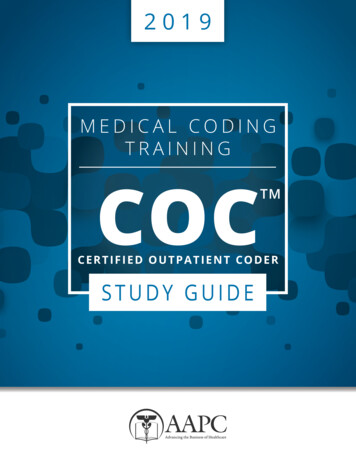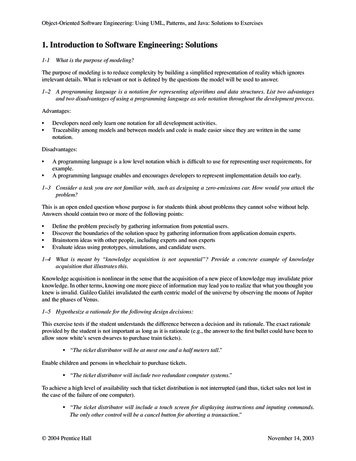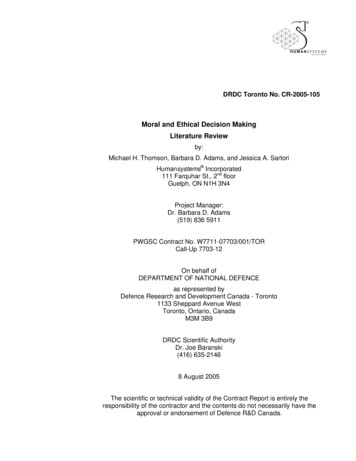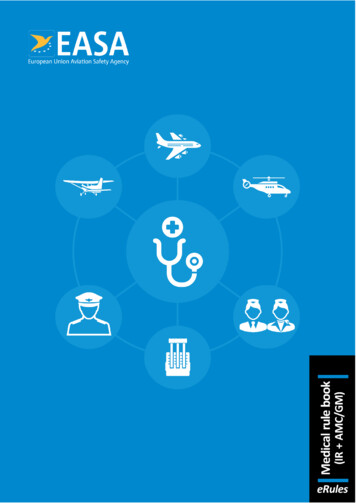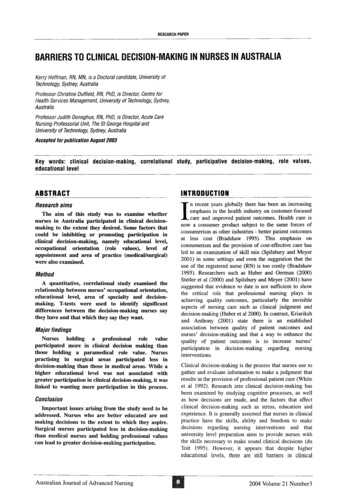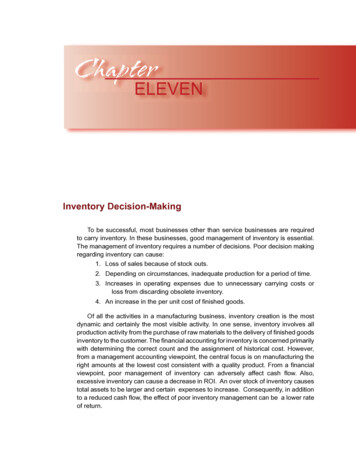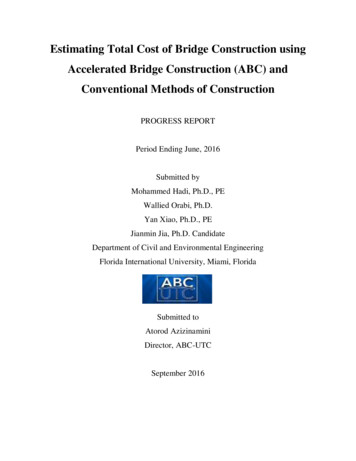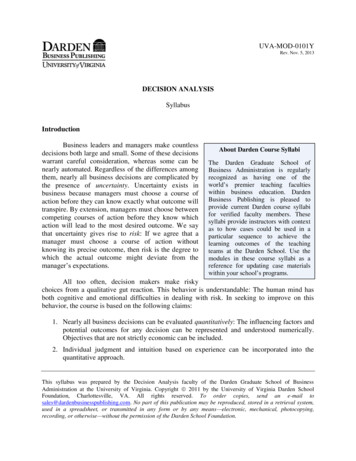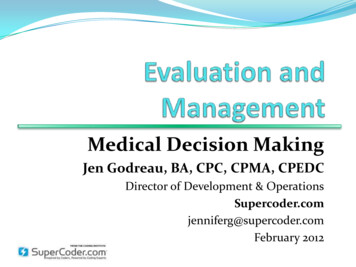
Transcription
Medical Decision MakingJen Godreau, BA, CPC, CPMA, CPEDCDirector of Development & bruary 2012
What’s he thinking?
What Is the Table of Risk? 1 of 7 tables in the 1995 and 1997 E/M Documentationand Coding Guidelines. 1 of 3 preliminary tables that you can use along withthe problem categories table and the type of datatable, to determine the level of decision-making
TableofRisk
Why Should I Use the Sheets? support for your physician’s code selection check your physicians’ levels Watch out: You might have to use a different audit toolfor some carriers. TrailBlazer (Medicare Part B carrier for Texas, Virginia,Maryland and Delaware) has developed its owncounting system
How Does Risk Tie Into MDM? Medical decision-making (MDM) is comprised of:1. Number of diagnoses or management options2. Amount and/or complexity of data to be reviewed3. Risk of complications and/or morbidity or mortality physician must meet or exceed 2 of the 3 elements
How Should I Evaluate Type? You can’t read your physician’s mind They can help you see what was involved bycompletely documenting the process include all diagnoses and any suspected problemsor concerns, including rule-outs Don’t overlook: You won’t code the rule-outs, butdocumenting them shows a more involved MDMtype.
What Should I Look For? To weigh the type of risk, zoom in on:1. Diagnosis2. Status3. Risks, treatments or management Map these to the CMS medical point-making system.
Example An ENT sees a patient with a diagnosis of otitis media(OM) and decides the patient requires tubes. Thephysician orders no tests and reviews no records. Thepatient is scheduled for tympanostomy (69436,Tympanostomy [requiring insertion of ventilating tube],general anesthesia).
Classify Problem’s Status - Table 1 Follow these rules: If the ENT has previously treated the patient for OM,CMS considers the problem established and awards 2points for an established problem that is inadequatelycontrolled, worsening or failing to progress as expected If this is the first time the ENT is treating the patient forOM, you should consider the diagnosis a new problem,which is worth three points
Table 1 – con’t Why is there a point difference? CMS expects that the decision-making for a knownproblem is less than that of a new problem Who is the problem new to? The sheet indicates “to the examiner”. The problem hasto be new to that provider. The increased score for a newproblem is given because working up a new probleminvolves more work than assessing a problem that isestablished or familiar to the physician.
Self-Limited or Minor Examples on Table of Risk: ColdInsect BiteTinea Corporosis assign 1 point
Self-Limited or Minor Definition: “A problem that runs a definite and prescribed course, istransient in nature, and is not likely to permanently alterhealth status OR has a good prognosis withmanagement/compliance.”
Table 1 – cont’d CMS guidelines state, “The assessment of risk of the presenting problem(s) isbased on the risk related to the disease processanticipated between the present encounter and the nextone.” Risk measures the chance of the patient becomingworse from the time he leaves the physician’s care tothe next visit. A common cold carries minimal risk, consistent with thedefinition of a minor or self-limited problem.
Example An established male patient previously diagnosed as acontrolled-diabetic presents with complaints of a runny noseand congestion without any other symptoms. Ignoring the co morbidities and listing only the presentingproblem diagnosis, will make the visit qualify for the lowest risklevel. The physician should also consider the effect the patient’sdiabetes has on management options, and if the physician treatsthe condition, they should report 250.00 (Diabetes mellitus )for addressing the underlying disease. Documentation guidelines state, “Co morbidities/underlyingdiseases or other factors that increase the complexity of medicaldecision making by increasing the risk of complications,morbidity, and/or mortality should be documented.”
Example An ENT sees a patient with a diagnosis of otitis media(OM) and decides the patient requires tubes. Thephysician orders no tests and reviews no records. Thepatient is scheduled for tympanostomy (69436,Tympanostomy [requiring insertion of ventilatingtube], general anesthesia).
Calculate Reviewed Data The ENT did not review any data so he receives a 0 inthis table. Remember to map your CPT codes to the areas listedin the Amount and/or Complexity of Data Reviewedtable. Give 1 point for clinical lab tests like urinalysis or astrep test. (80000 series codes) Don’t miss: The table counts medicine tests (90000codes) separately. If a physician reviews an x-ray andorders an ECG, give 1 point for each of these tests.
Don’t Double Dip! If the physician is coding the service like an x-ray,allergy testing, or an ENG at this service or another,they are already receiving credit for the review in thetest code. Give points for work the physician could not otherwiseget credit for. ei: a strep test that an outside lab is reading or an x-raythat an outside radiologist reads “Do not report [E/M] services for test interpretationand report.”
Data – cont’d Poor historian record who the historian is why the patient is not giving the history.
Example A babysitter attempting to give the history for a smallchild. If time doesn’t dominate these encountersqualifying them for time-based coding, consider givinga point in this table for “decision to obtain historyfrom someone other than parent.”The Coding Institute LLC, 2222 Sedwick Drive, Durham, NC 27713 Phone: (866)-228-9252 E-Mail: customerservice@supercoder.com22
Select Risk Level based on the single highest element identified in thetable of risk’s three columns (1 of 3). Do not need one element in each column.
Look to History OM Patient Should you classify OM with a decision for tubes as apresenting problem that is stable chronic (low), acuteuncomplicated illness (low), or acute illness withsystemic symptoms (moderate)? If there is documented hearing loss, balancedysfunction, speech/language delay, tympanicmembrane rupture, you could argue that it representsan acute or chronic illness that may pose a risk to lossof function, classifying the presenting problem ashigh.
Count Tests/Labs - Column 2 To calculate the diagnostic procedures level, you’llfocus on any workup the Otolaryngologist ordered. Because the physician in the OM case study did notorder or review any diagnostic procedures, you have nocircle in column two.
Tip: Check Hx check if the patient has any identified risk factors refers to the patient’s unique medical history thatmight affect the outcome. Asthma example: circle "minor surgery with identified risk factors” ups level from low to moderate.
Jump to ‘High’ for Risk Exceptions “diagnostic endoscopies with no identified riskfactors” moderate risk “diagnostic endoscopies with identified risk factors” high risk Don’t increase the risk factor just because the patient’sundergoing a scope.
Jump to ‘High’ for Risk Exceptions Do this: Usually give a physician moderate risk creditfor ordering a scope. All patients undergoing anendoscopy face a certain amount of risk, so theordering of the endoscopy is always the same. Exception: If a patient has identified risk factors,increase the risk factor from “moderate” to “high”.
Weighing Medication Moderate Giving samples involves this same process. How AMA Weighs Managing Drugs The table of risk in the AMA-approved 1995 E/Mguidelines lists prescription drug management as acommon clinical example of moderate risk. The providerhas to evaluate the suitability of the patient for themedication and weigh the benefits and risks.
Weighing Medication – cont’d What Counts as Prescription/Drug? Giving samples with or without a prescription all falls underprescription drug management. The process of prescriptiondrug management would include giving the patient the actualmeds as samples, the thought process and risk would remainthe same as writing it down on a piece of paper. Example: A female patient has allergic rhinitis. The allergist gives hersamples of Astelin to try as needed. He tells the patient to callin for a prescription if she feels the prescription helps. Thiscase constitutes prescription management.
OTC low risk Risk assessment relates to the disease processanticipated between the present encounter and thenext one.
Identify Risk With Highest Circle chronic otitis media with effusion (381.3) anddocumentation support a chronic illness with progression, child who is new to the ENT has no comorbidities. Assign the level based on the highest circle. The highest level is moderate.
Tally Final MDM enter the 3 tables’ scores in the Final Result forComplexity table. Determine the final score using 2/3 elements.
No Column Has 2 Circles draw a line down the column with the second circle fromthe left Example: A patient has allergic rhinitis that’s usually controlled withAllegra-D but weather changes trigger the patient’s allergies,which precipitates her sinusitis. The patient’s sinusitis is anew problem to the pediatrician and he plans no additionalwork-up and orders no tests. The patient, an adolescent, givesher own history. The pediatrician has previously treated thepatient’s allergies and writes her a prescription telling her tofill it if after she finishes the samples provided. She decidesthe Xyzal is decreasing her sinusitis and allergic rhinitisexacerbations.
No Column Has 2 Circles
Combining History, Exam, MDM Example: When a patient comes into the office complaining ofchest pain, we often order lab work, an ECG, and sendthe patient to the hospital. These instances involvemoderate to high risk but we do not perform acomplete review of systems (ROS) due to thepresenting problem’s emergent nature. Will these be level 4 or 5 established patient officevisits?
Answer: Choose level based on the medically necessary history,exam, and medical decision making (MDM) that isperformed and documented at each encounter. Probable combos: detailed history detailed/comprehensive exam mod/high MDM MDM, plus the amount of exam, ultimately determinewhether 99214 or 99215.
MDM 4 points in the "Number of Diagnoses or TreatmentOptions" area for the new problem to provider withadditional work-up planned total of 2 points in the "Amount and/or Complexity of Datato be Reviewed" section. 1 point for ordering lab work 1 point for ordering the ECG Because the diagnoses level puts you at a high level and thedata amount is at a low level, the risk will determinewhether the MDM is high complexity (if risk is high) ormoderate complexity (if risk is moderate).
History Extended HPI - asking the patient about the severity,duration, quality, context, etc. of the pain Pertinent PFSH - any past personal or family history ofheart disease Detailed ROS - questions about the constitutional andcardiac systems Extended HPI extended ROS pertinent PFSH detailed history.
Which Exam Level? Comprehensive exam - 8 or more systems -- such asconstitutional, eyes, ENT, detailed cardio, respiratory,skin, neurological, and psychological Detailed exam - If the severity didn’t allow foranything other than constitutional (vitals, generalappearance) and detailed cardio, you may still be at adetailed exam.
AAPC April 1-4 Visit SuperCoder.comBooth100 Get mini ICD-10 Training Jen Godreau AHIMA certified ICD-10 training instructor SuzanneLeder, CPC, COBGC Win SuperCoder T-shirts, mouse pads, & more!
Thank youSuperCoder.comBetter Coding!
If the physician is coding the service like an x-ray, allergy testing, or an ENG at this service or another, they are already receiving credit for the review in the test code. Give points for work the physician could not otherwise get credit for. ei: a strep test that an outside lab is reading or an x-ray that an outside radiologist reads

